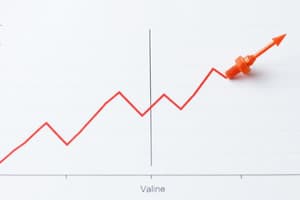Podcast
Questions and Answers
What does the real rate of interest reflect?
What does the real rate of interest reflect?
- The true earning power of money adjusted for inflation (correct)
- The average interest rate across different types of loans
- The nominal interest rate without inflation adjustment
- The potential return on investments without considering inflation
How do central banks use real interest rates?
How do central banks use real interest rates?
- To determine the total amount of loans available for borrowing
- To guide monetary policy decisions (correct)
- To assess overall economic growth rates
- To set inflation targets for the economy
What happens to the cost of borrowing when real interest rates are low?
What happens to the cost of borrowing when real interest rates are low?
- The real interest rate has no effect on borrowing costs
- Borrowing becomes more expensive, discouraging spending
- Borrowers face higher costs due to increased demand for loans
- Borrowing costs are effectively reduced, encouraging spending (correct)
What is the relationship between nominal rates and real rates when inflation rises?
What is the relationship between nominal rates and real rates when inflation rises?
What effect do high real interest rates have on economic growth?
What effect do high real interest rates have on economic growth?
What does mean-variance analysis help investors to determine?
What does mean-variance analysis help investors to determine?
In the context of mean-variance analysis, what does variance represent?
In the context of mean-variance analysis, what does variance represent?
What is the primary goal of the mean-variance criterion?
What is the primary goal of the mean-variance criterion?
Why do investors adjust nominal returns for inflation?
Why do investors adjust nominal returns for inflation?
What type of inflation occurs when demand exceeds supply?
What type of inflation occurs when demand exceeds supply?
What causes cost-push inflation?
What causes cost-push inflation?
What is built-in inflation commonly related to?
What is built-in inflation commonly related to?
How does mean-variance analysis benefit an investor's portfolio?
How does mean-variance analysis benefit an investor's portfolio?
Flashcards are hidden until you start studying
Study Notes
Mean-Variance Analysis
- A tool for investors to assess the risk and reward of their investments.
- Helps investors understand the likelihood of their investments returning the expected profit.
- Evaluates investments based on the trade-off between expected returns (mean) and risk (variance).
- The mean represents the average outcome of an investment over time.
- Variance measures how much investment returns deviate from the mean (risk).
- Allows investors to find the highest reward at a given risk level or vice versa.
Inflation
- Represents the general increase in prices over time, eroding purchasing power.
- Nominal returns must be adjusted for inflation to determine the real growth in purchasing power.
- Can reduce the real value of fixed-income securities (e.g., bonds) due to fixed interest payments losing value as prices rise.
Types of Inflation
- Demand-Pull Inflation: Occurs when demand for goods and services exceeds supply, leading to higher prices.
- Cost-Push Inflation: Results from increased production costs (e.g., wages, raw materials), causing producers to raise prices.
- Built-In Inflation (Wage-Price Inflation): Arises when businesses increase prices anticipating higher wage demands from employees.
Real Rate of Interest
- The nominal interest rate adjusted for inflation.
- Reflects the true earning power of money, accounting for the loss of purchasing power due to inflation.
- A positive real rate indicates an investment's return exceeds inflation, enhancing purchasing power.
- Central banks monitor real rates to guide monetary policy.
- Affects the cost of borrowing for businesses and consumers.
- Low or negative real rates can encourage borrowing and spending, stimulating economic activity.
Relationship between Nominal and Real Rates
- When inflation rises, if nominal rates do not increase correspondingly, real rates fall.
- Investors anticipating higher inflation demand higher nominal rates to compensate for the expected loss of purchasing power, potentially leading to higher real interest rates.
- High real interest rates make borrowing more expensive, potentially slowing economic growth.
- Conversely, low real rates can encourage borrowing and spending, stimulating economic activity.
Studying That Suits You
Use AI to generate personalized quizzes and flashcards to suit your learning preferences.




